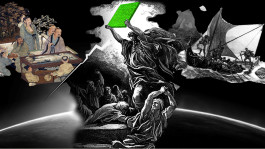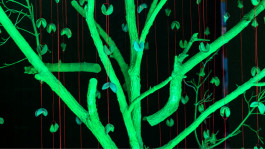“NATURE IS AN IDEA”
January 1, 2017
BAM grapples with the culturally diverse ideas about nature that shape our built environment.
How we perceive NATURE is rooted in the way cultures define the self.
Greek western philosophical thought pits the individual out into the world. The individual is created through the journey and the hardships endured when encountering the unknown. This sets up an adversarial, combative mentality towards external conditions. Hence the individual is forged by experiences facing nature.
In eastern philosophical thought, particularly Chinese Confucianism, the individual is highly responsible for the familial unit, a microcosm for the village, province, land, and empire. The individual’s relationship to external conditions is defined neither through agitation nor conflict. Instead it is possible for the individual to be auspiciously placed within nature; conversely, nature can be controlled to create ideal conditions. Extrapolated through eastern history is this belief that it is possible to construct nature, whereby nature is more appropriate, advantageous, and excellent than nature could naturally be.
Respective definitions of nature are reflected in our urban conditions. Whether we collectively define the city as nature or not, shapes our cities. Whether we collectively see parks as nature, or as the constructed environment, shapes our cities. Whether we understand nature and the landscape to be one in the same, or as utterly different, shapes our built environment. How these questions are answered is culturally determined. Where China sees nature is not where America sees nature.
Views on where nature lies, and what the human role is in shaping nature, create drastically different outlooks towards our urban environment, and drastically different understandings of where the landscape lies within that construct.
Within BAM’s project work, several installations make reference to BAM’s motto, ‘NATURE IS AN IDEA’. The “Fortune Cookie Tree” installed at BAM’s “10 Years of Dumb” retrospective exhibition represents perhaps most clearly to date the interdependence between ‘real’ and ‘artificial’ nature, central to ‘NATURE IS AN IDEA.’

Landscape is a unique and many-splendored medium. Throughout various time periods in history what people believed it should appear like has vacillated between that which is not constructed by humans and that which is. Traditionally art has been defined almost purely by what is created by humans. When considering the spectrum of art history, only recently has the idea of art as that created by nature come into the discourse. Eliasson’s piece of a melting iceberg placed in a plaza, or Hirst’s coral, barnacles, and various forms of sea life growing on objects placed underwater, come to mind. Stepping outside of contemporary art we can start to find many more instances of the control of nature being considered an art form, the practice of bonsai clearly begins to dovetail with ideas of landscape.
Barring a few examples here and there, it is difficult to define art in terms other than that which is created by humans. Thus, in essence art represents an idea of being constructed, as such if landscape is to be considered as something which is constructed, than it opens a door in which landscape can be considered art.
During the 60’s and 70’s in America, the land-art movement gave rise to a generation of landscape architects in which landscape and art were inextricable. Yet as the awareness regarding environmental issues has grown significantly since that time, the practice of landscape is yet again swinging away from the idea of landscape appearing to be constructed and towards the idea of it looking natural. The majority of humans live in urban conditions as such, most of the landscapes which humans interact with are constructed, thus to deny the understanding of landscape as a constructed cultural medium devalues its inherent power.
If landscape is to be considered as something which is not man-made and only made by nature, or merely appear to be made by nature, then this closes the door to it being considered as an art form. These two extremes are inherent in the practice and design of landscape. This conflict inherent in landscape is also what allows it to be disconnected from the timeline of art or architecture. It is precisely in this conflict where great landscape design is born: it is rooted in the idea that the artist is someone who looks to nature for inspiration and sees beyond the natural to some other ideal form.
“NATURE IS AN IDEA”
January 1, 2017
BAM grapples with the culturally diverse ideas about nature that shape our built environment.
How we perceive NATURE is rooted in the way cultures define the self.
Greek western philosophical thought pits the individual out into the world. The individual is created through the journey and the hardships endured when encountering the unknown. This sets up an adversarial, combative mentality towards external conditions. Hence the individual is forged by experiences facing nature.
In eastern philosophical thought, particularly Chinese Confucianism, the individual is highly responsible for the familial unit, a microcosm for the village, province, land, and empire. The individual’s relationship to external conditions is defined neither through agitation nor conflict. Instead it is possible for the individual to be auspiciously placed within nature; conversely, nature can be controlled to create ideal conditions. Extrapolated through eastern history is this belief that it is possible to construct nature, whereby nature is more appropriate, advantageous, and excellent than nature could naturally be.
Respective definitions of nature are reflected in our urban conditions. Whether we collectively define the city as nature or not, shapes our cities. Whether we collectively see parks as nature, or as the constructed environment, shapes our cities. Whether we understand nature and the landscape to be one in the same, or as utterly different, shapes our built environment. How these questions are answered is culturally determined. Where China sees nature is not where America sees nature.
Views on where nature lies, and what the human role is in shaping nature, create drastically different outlooks towards our urban environment, and drastically different understandings of where the landscape lies within that construct.
Within BAM’s project work, several installations make reference to BAM’s motto, ‘NATURE IS AN IDEA’. The “Fortune Cookie Tree” installed at BAM’s “10 Years of Dumb” retrospective exhibition represents perhaps most clearly to date the interdependence between ‘real’ and ‘artificial’ nature, central to ‘NATURE IS AN IDEA.’

Landscape is a unique and many-splendored medium. Throughout various time periods in history what people believed it should appear like has vacillated between that which is not constructed by humans and that which is. Traditionally art has been defined almost purely by what is created by humans. When considering the spectrum of art history, only recently has the idea of art as that created by nature come into the discourse. Eliasson’s piece of a melting iceberg placed in a plaza, or Hirst’s coral, barnacles, and various forms of sea life growing on objects placed underwater, come to mind. Stepping outside of contemporary art we can start to find many more instances of the control of nature being considered an art form, the practice of bonsai clearly begins to dovetail with ideas of landscape.
Barring a few examples here and there, it is difficult to define art in terms other than that which is created by humans. Thus, in essence art represents an idea of being constructed, as such if landscape is to be considered as something which is constructed, than it opens a door in which landscape can be considered art.
During the 60’s and 70’s in America, the land-art movement gave rise to a generation of landscape architects in which landscape and art were inextricable. Yet as the awareness regarding environmental issues has grown significantly since that time, the practice of landscape is yet again swinging away from the idea of landscape appearing to be constructed and towards the idea of it looking natural. The majority of humans live in urban conditions as such, most of the landscapes which humans interact with are constructed, thus to deny the understanding of landscape as a constructed cultural medium devalues its inherent power.
If landscape is to be considered as something which is not man-made and only made by nature, or merely appear to be made by nature, then this closes the door to it being considered as an art form. These two extremes are inherent in the practice and design of landscape. This conflict inherent in landscape is also what allows it to be disconnected from the timeline of art or architecture. It is precisely in this conflict where great landscape design is born: it is rooted in the idea that the artist is someone who looks to nature for inspiration and sees beyond the natural to some other ideal form.



